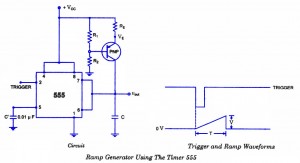Ramp Generator Circuit-using 555 Timer IC
We know that if a capacitor is charged from a voltage source through a resistor, an exponential waveform is produced while charging of a capacitor from a constant current source produces a ramp. This is the idea behind the circuit. The circuit of a ramp generator using timer 555 is shown in figure. Here the resistor of previous circuits is replaced by a PNP transistor that produces a constant charging current.

Charging current produced by PNP constant current source is
iC = Vcc-VE / RE
where VE = R2 / (R1 + R2) * VCC + VBE
When a trigger starts the monostable multivibrator timer 555 as shown in figure, the PNP current source forces a constant charging into the capacitor C. The voltage across the capacitor is, therefore, a ramp as illustrated in the figure. The slope of the ramp is given as
Slope, s = I/C

2 Comments
what is Ramp generater?
Very helpful information, one question though.
Looking at the “saw” waveform of a capacitor charging via resistor, this page states that it charges exponentially. However, isn’t it the inverse of exponential, as it rises quickly but slows as it approaches the maximum, being the asymptote, whereas exponential would start charging slowly then climb more quickly as it neared the maximum? Isn’t there another term for describing the inverse-exponential curve towards the asymptote?